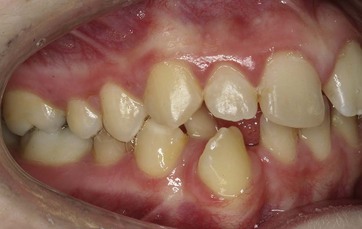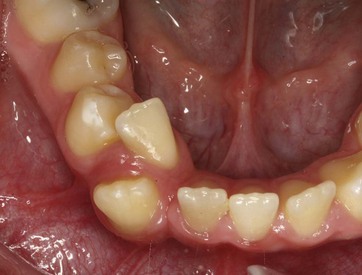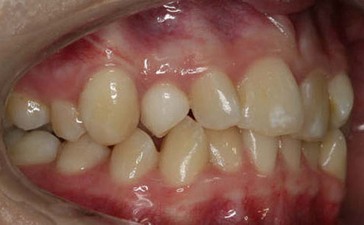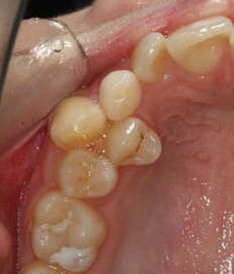7 More canine problems
Cases 1 and 2
 What do you notice in Figure 7.1?
What do you notice in Figure 7.1?
 What do you notice in Figure 7.2?
What do you notice in Figure 7.2?
Mild marginal gingival erythema related to most teeth, more marked interproximally.
 What factors would you consider in treatment?
What factors would you consider in treatment?
Table 7.1 Factors to consider in treatment planning for transposition
| Factor(s) | Reason(s) |
|---|---|
| Underlying malocclusion, facial aesthetics, degree of crowding | These will influence need for extraction(s) |
| Stage of dental development and position of root apices | When root development is complete, interception (by extraction of primary teeth) is unlikely to lead to spontaneous improvement in tooth position |
| With complete transposition and root apices closed, acceptance of transposition may be best due to the root resorption and periodontal (e.g. gingival recession, alveolar dehiscence) risks involved in correction | |
| Dental morphology | If transposition is to be maintained, re-shaping is necessary to disguise for incorrect tooth position |
| Occlusal considerations | Judicious grinding of the palatal cusp of a maxillary first premolar will be required where it is aligned in the canine position |
 What are the treatment options?
What are the treatment options?
Interceptive treatment: if detected early (on average, between 6 and 8 years), extraction of primary teeth may be undertaken in an attempt to guide the transposed teeth to their normal positions while ensuring that space is maintained either by an upper removable appliance/palatal bar or lingual arch. This approach is only possible where the teeth affected are tilted so their roots are near the desired positions (sometimes called pseudotransposition).
Acceptance: especially if transposition and root formation are complete, followed by reshaping of incisal/occlusal surfaces and/or composite additions to camouflage for tooth position.
Extraction of the most displaced tooth: this strategy has been recommended where the arch is crowded or for caries; appliance therapy may be required thereafter.
Stay updated, free dental videos. Join our Telegram channel

VIDEdental - Online dental courses


 visible with
visible with  erupting mesial of
erupting mesial of  .
.
 ;
;  bodily displaced lingually and tilted distally;
bodily displaced lingually and tilted distally;  rotated distobuccally; space between
rotated distobuccally; space between  . Class I incisor relationship.
. Class I incisor relationship. in crossbite with
in crossbite with  .
.

 visible with
visible with  erupted forward of
erupted forward of  and displaced palatally.
and displaced palatally. ; distopalatal rotation of
; distopalatal rotation of  ; mesiolabial rotation of
; mesiolabial rotation of  was in buccal crossbite with
was in buccal crossbite with  ).
).




 and
and  almost exclusively.
almost exclusively.
